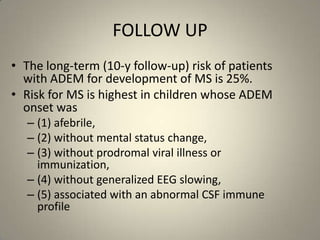Adem
- 1. IMAGE OF THE WEEK THELENGANA A PG 1STYR FROM IMCU WARD
- 2. • 15 Yrs old female presented with h/o Fever 2 days Asymptomatic 10 days Headache,vomiting Altered sensorium for 1 week No h/o seizures/visual disturbance No h/o vaccination /exanthematous illness
- 3. O/E vitals were stable CNS examn :Pt was drowsy , arousable with painful stimulus PERL , DEM preserved exaggerated DTR B/L plantar extensor fundus examination – B/L disc edema Other systemic examination was unremarkable
- 10. CNS TUBERCULOSIS
- 12. PML
- 13. ACUTE DISSEMINATED ENCEPHALOMYELITIS  Inflammatory, nonvasculitic, demyeli nating, immune mediated, monophasic and polysymptomatic disease of the central nervous system Post infectious encephalomyelitis, Post vaccination encephalomyelitis
- 14. PATHOGENESIS • Molecular mimickery: brain vaccines – Th2 lymphocytes have increased reactivity to myelin basic protein • Inflammatory cascade concept: – CNS infections triggering immune response, damage to BBB, brain specific antigens spills into systemic circulation and initiates immunologic process
- 15. ADEM MULTIPLE SCLEROSIS PRODROMAL PHASE NO PRODROMAL PHASE ALTERED SENSORIUM PRESERVED AWARENESS MENINGISMUS NO MENINGISMUS NEUROSYCHIATRIC DISORDER NO NEUROPSYCHIATRIC B/L OPTIC NEURITIS UNILATERAL OPTIC NEURITIS COMPLETE TRANSVERSE MYELITIS INCOMPLETE SEIZURES DIPLOPIA ATAXIA RELAPSING MONOPHASIC POLYPHASIC POLYSYMPTOMATIC MONOSYMPTOMATIC
- 16. INVESTIGATIONS CSF ANALYSIS CT BRAIN MRI – T2 , FLAIR, CONTRAST – MTR EEG,VEP
- 17. NEUROIMAGING • MRI: extensive, multifocal, subcortical white matter abnormalities • MRI: subcortical white matter, may be grey matter also, • CT may be normal in 50% cases • Convalescent MRI helpful in diffrentating with MS, new lesions in MS
- 18. MRI Features ADEM • Patchy, poorly marginated areas of increased signal intensity; large, asymmetric, multiple • Four patterns: – ADEM with less than 5 mm lesions – Large, confluent lesions with edema and mass effect – ADEM with additional symmetric bithalamic involvement – Acute hemorrhagic encephalomyelitis (worst prognosis)
- 19. RECURRENCE OF ADEM RDEM MDEM
- 20. TREATMENT • Broad spectrum antibiotics and acyclovir until an Infectious etiology is excluded. • Methylprednisolone in a dose of 30 mg/kg per day intravenously up to a maximum dose of 1000 mg per day X 5 days • Plasmapharesis • Intravenous immunoglobulin • Cyclosporin , cyclophosphamide • Methylpred + IVIG
- 21. PROGNOSIS • Mortality: 10% in older studies, Now <2% • Morbidity: visual, motor, autonomic, and intellectual deficits and epilepsy. – Problems persist after the first few weeks of illness in only about 35% of cases, and in most of these patients, the deficits resolve within 1 year of onset.
- 22. FOLLOW UP • The long-term (10-y follow-up) risk of patients with ADEM for development of MS is 25%. • Risk for MS is highest in children whose ADEM onset was – (1) afebrile, – (2) without mental status change, – (3) without prodromal viral illness or immunization, – (4) without generalized EEG slowing, – (5) associated with an abnormal CSF immune profile






















